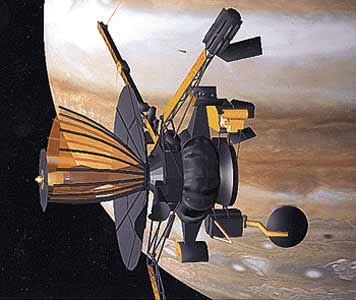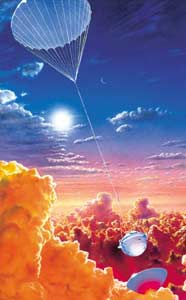Thank you very much for visiting Gunter's Space Page. I hope that this site is useful and informative for you.
If you appreciate the information provided on this site, please consider supporting my work by making a simple and secure donation via PayPal. Please help to run the website and keep everything free of charge. Thank you very much.
Galileo

Galileo [NASA]

Galileo Probe [NASA]
The Galileo mission consists of two spacecraft: an orbiter and an atmospheric probe. Launched during the STS 34 flight of the Atlantis orbiter, the two spacecraft were kicked out of Earth orbit by an inertial upper stage (IUS) rocket, sending them careening through the inner solar system. The trajectory which the spacecraft followed was called a VEEGA (Venus-Earth-Earth Gravity Assist), traveling first in toward the Sun for a gravity assist from Venus before encountering the Earth two times (spaced two years apart). These encounters with Venus and the Earth allowed Galileo to gain enough velocity to get it out to Jupiter.
During the flybys of Venus and the Earth, Galileo scientists took the opportunity to study these two planets as well as the Moon, making some unprecedented observations as a result. In addition, following each Earth flyby, Galileo made excursions as far out in the solar system as the asteroid belt, enabling scientists to make the first close-up studies of two asteroids, Gaspra and Ida. As is this were not sufficient, Galileo scientists were fortunate to be the only ones with a direct view of the Comet Shoemaker-Levy 9 fragment impacts on Jupiter. All of this was prior to the primary missions of sending an atmospheric probe into Jupiter's atmosphere and studying Jupiter, its satellites, and its magnetosphere for two years with the orbiter.
Interplanetary studies were also made sporadically by some of the other Galileo instruments, including the dust detector, magnetometer, and various plasma and particles detectors, during its six year journey to Jupiter.
The probe was released from the orbiter 147 days prior to its entry into the Jovian atmosphere on 7 December 1995.
The objectives of the Galileo Orbiter are to:
- investigate the circulation and dynamics of the Jovian atmosphere;
- investigate the upper Jovian atmosphere and ionosphere;
- characterize the morphology, geology, and physical state of the Galilean satellites;
- investigate the composition and distribution of surface minerals on the Galilean satellites;
- determine the gravitational and magnetic fields and dynamic properties of the Galilean satellites;
- study the atmospheres, ionospheres, and extended gas clouds of the Galilean satellites;
- study the interaction of the Jovian magnetosphere with the Galilean satellites; and,
- characterize the vector magnetic field and the energy spectra, composition, and angular distribution of energetic particles and plasma to a distance of 150 Rj.
The science goals of the Galileo Probe (Hughes HS-373 type) were to:
- determine the chemical composition of the Jovian atmosphere;
- characterize the structure of the atmosphere to a depth of at least 10 bars;
- investigate the nature of cloud particles and the location and structure of cloud layers;
- examine the Jovian radiative heat balance;
- study the nature of Jovian lightning activity; and,
- measure the flux of energetic charged particles down to the top of the atmosphere.
Galileo was deorbited at the end on the mission to avoid contaminating the moon Europa. It burned up in the Jupter atmosphere on 21 September 2003.
| Nation: | USA |
|---|---|
| Type / Application: | Jupiter orbiter and probe |
| Operator: | NASA |
| Contractors: | |
| Equipment: | |
| Configuration: | |
| Propulsion: | S400 |
| Power: | 2 GPHS-RTG |
| Lifetime: | 2223 kg (launch) |
| Mass: | |
| Orbit: |
| Satellite | COSPAR | Date | LS | Launch Vehicle | Remarks | |
|---|---|---|---|---|---|---|
| Galileo | 1989-084B | 18.10.1989 | CCK LC-39B | Shuttle [IUS] | with Atlantis F5 (STS 34), Galileo Probe | |
| Galileo Probe | 1989-084# | 18.10.1989 | CCK LC-39B | Shuttle [IUS] | with Atlantis F5 (STS 34), Galileo |
References:
- NSSDC Master Catalog: Galileo Orbiter
- NSSDC Master Catalog: Galileo Probe
- Boeing: Galileo Probe
